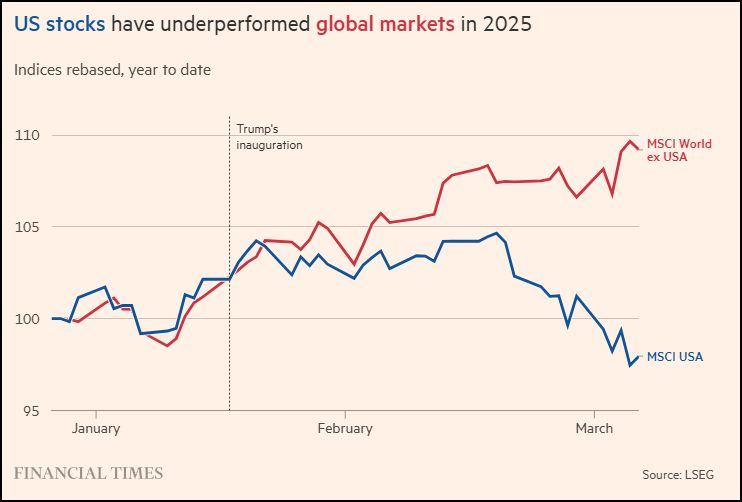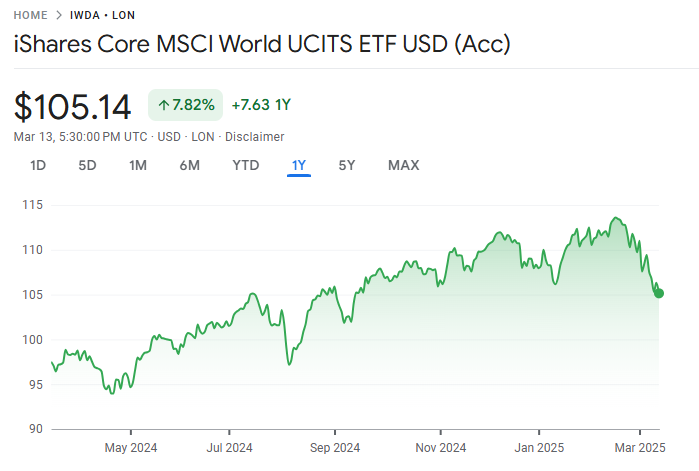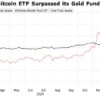

Understanding the Indices: S&P 500, MSCI USA, and MSCI World ex USA
The S&P 500 Index tracks the performance of 500 large-cap U.S. companies, covering approximately 80% of the U.S. equity market capitalization. It is a market-capitalization-weighted index, meaning larger companies like Apple and Microsoft have a greater influence on its performance. The SPY ETF, which tracks the S&P 500, provides a reliable proxy for its movements, showing a decline from $601.82 in January 2025 to $552.741 by March 13, 2025—a rebased drop from 100 to 91.84.
The MSCI USA Index, on the other hand, measures the performance of large- and mid-cap U.S. companies, representing about 85% of the U.S. market’s free float-adjusted market capitalization. While similar to the S&P 500, it includes a broader range of mid-cap stocks, with 609 constituents compared to the S&P 500’s 500. Despite this slight difference, the two indices have historically moved in tandem, with the MSCI USA also declining by 5% in 2025, as shown in the Financial Times chart.
In contrast, the MSCI World ex USA Index tracks large- and mid-cap companies across 22 developed markets outside the U.S., such as Japan, the UK, and Germany. It excludes U.S. stocks, providing a clear benchmark for global market performance independent of the U.S. Its 5% gain in 2025 highlights a stark contrast to the U.S. indices’ declines, suggesting that global investors are finding better opportunities outside the U.S.
The Turning Point: Trump’s Inauguration and Policy Impacts
The Financial Times chart pinpoints late January 2025—coinciding with Trump’s inauguration—as the moment when U.S. and global market performances began to diverge. This timing suggests that policy changes under the new administration may have contributed to the underperformance of U.S. stocks. While specific policy details are unavailable, historical precedents and posts on X provide some clues.
Moreover, the S&P 500’s heavy reliance on multinational companies—40% of whose revenues come from outside the U.S., according to investingintheweb.com—means that a stronger U.S. dollar or trade barriers could dampen earnings from foreign markets. In contrast, the MSCI World ex USA benefits from a more balanced sector exposure, with greater representation from industrials and consumer goods in markets like Europe and Japan, which may be less affected by U.S.-centric policies.

Sectoral Dynamics: Tech’s Struggles and Global Resilience
The S&P 500 and MSCI USA’s underperformance can also be attributed to sectoral dynamics. The S&P 500’s significant weighting in technology has historically driven its outperformance, particularly during the post-2008 period when U.S. tech giants led global innovation. However, in 2025, this concentration may have become a liability. Disappointing earnings from tech firms, as noted in X posts, combined with potential regulatory scrutiny or a slowdown in AI-driven growth, could be dragging down U.S. indices. The SPY ETF’s 8.16% decline suggests that tech-heavy sectors are under pressure, as the S&P 500 underperformed the broader MSCI USA by 3 percentage points. Could be due to stronger economic growth in Europe, a recovery in manufacturing, or favorable monetary policies from the European Central Bank. Additionally, the MSCI World ex USA’s diversification across 22 countries mitigates the impact of any single market’s downturn, providing a buffer against U.S.-specific challenges.
Global Economic Conditions: A Shift in Investor Sentiment
Beyond U.S. policy, broader economic conditions are likely contributing to the divergence. The MSCI World ex USA’s 5% gain suggests that global investors are finding opportunities in non-U.S. markets, possibly due to stronger growth prospects or more attractive valuations. For instance, European and Japanese markets may be benefiting from post-pandemic recovery, green energy investments, or digital transformation initiatives, as noted in long-term S&P 500 forecasts on litefinance.org, which highlight the role of innovation and sustainability in driving global growth.
In contrast, U.S. markets may be facing headwinds from inflation uncertainty and employment concerns, as mentioned in X posts. The Federal Reserve’s monetary policy decisions—potentially tightening to combat inflation—could be weighing on U.S. equities, particularly growth stocks in the S&P 500 that are sensitive to interest rate hikes. Meanwhile, a stronger U.S. dollar, often a byproduct of tighter monetary policy, could reduce the competitiveness of U.S. exports, further impacting multinational companies within the S&P 500 and MSCI USA.

Implications for Investors: Diversification Matters
The underperformance of U.S. stocks in 2025 underscores the importance of diversification for investors. Relying solely on the S&P 500 or MSCI USA exposes portfolios to U.S.-specific risks, such as policy uncertainty or sector concentration. The MSCI World ex USA’s outperformance highlights the benefits of global diversification, which can mitigate the impact of downturns in any single market.
For U.S.-based investors, this trend may prompt a reevaluation of asset allocation. While the S&P 500 has been a reliable long-term investment—delivering a 5.42% gain from March 2024 to March 2025 despite the year-to-date decline—its current trajectory suggests that allocating a portion of a portfolio to non-U.S. developed markets could provide a hedge against domestic volatility. ETFs tracking the MSCI World ex USA, such as the iShares Core MSCI World ex USA ETF, offer an accessible way to achieve this exposure.
Critical Examination: Is This a Lasting Shift?
While the data clearly shows U.S. stocks lagging in 2025, it’s worth critically examining whether this trend signals a lasting shift. The S&P 500’s long-term average annual return of around 10% suggests resilience, and its current decline may be a short-term correction rather than a structural change. The U.S. economy remains a global leader in innovation, and tech giants within the S&P 500 could rebound if earnings improve or policy uncertainties subside.
Moreover, the MSCI World ex USA’s gains may be driven by temporary factors, such as a weaker U.S. dollar or cyclical recovery in Europe. If U.S. policies stabilize and global growth slows, U.S. stocks could regain their leadership. However, the increasing weight of non-U.S. markets in the global economy—evidenced by the MSCI World ex USA’s performance—suggests that investors should not assume U.S. dominance will persist indefinitely. The narrative of U.S. underperformance, while compelling, may be overstated if viewed solely through the lens of a single quarter.
Our opinion
The first quarter of 2025 has revealed a significant divergence in global equity markets, with the S&P 500 and MSCI USA falling behind the MSCI World ex USA. Driven by a combination of U.S.-specific policy challenges, sectoral weaknesses, and shifting global economic conditions, this trend highlights the risks of over-reliance on U.S. equities. For investors, the lesson is clear: diversification across global markets is crucial in an increasingly interconnected world. While the S&P 500 and MSCI USA may rebound, the rise of global markets in 2025 serves as a reminder that opportunities—and risks—are not confined to any single region. As the year progresses, monitoring U.S. policy developments, sectoral trends, and global economic indicators will be key to navigating this evolving landscape.



















